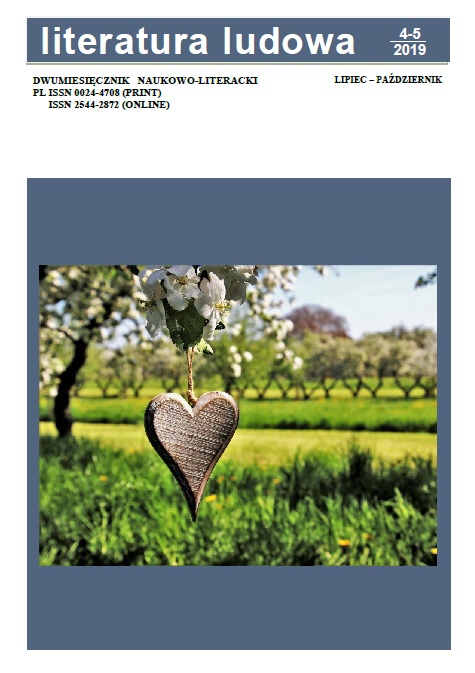Ligawa Playing in the Lublin Region: Contemporary Discoveries and Continuation of a Local Musical Practice
DOI:
https://doi.org/10.12775/LL.4-5.2019.002Keywords
traditional music in the Lublin region, ligawa playing, building of folk musical instruments, aerophones in folk culture, reconstruction of intangible cultural heritageAbstract
The article presents the most recent research on the reactivation of an old musical tradition in the Lublin region, called “trumpet blowing at Advent.” This custom is connected with playing an aerophone named ligawa and with a local practice of making this instrument. The ligawa or ligawka has an eventful history of presence in Poland. In the folk culture, it is associated with the signalling function widespread among shepherds in the mountains. The current research is focused on the ritual practice connected with the liturgical period of Advent in the Roman Catholic Church. The presence of this custom has been confirmed in the neighbouring regions of Mazowsze and Podlasie.
The author reviews the ethnographical descriptions of the ritual ligawa playing in the Lublin region and compares them with the results of her own field research conducted in villages near Lublin since 2008. The author attempts to answer the question to which extent contemporary societies are able to revive and practise on a regular basis forgotten rites of the musical character. In the study contains examples of documented instruments, descriptions of instrument playing circumstances and profiles of the depositaries of this tradition: ligawa players and makers from the Lublin region.
The discussed subject is part of a broader discussion on the issues of preserving and safeguarding intangible cultural heritage and – due to its topicality – requires continuation and comparison with similar undertakings in the field of revival of local musical practices.
Key words: traditional music in the Lublin region, ligawa playing, building of folk musical instruments, aerophones in folk culture, reconstruction of intangible cultural heritage
References
CHMARA, J. (1937). Lubelska Pieśń Ludowa, cz. 1. Lwów-Warszawa: Książnica Atlas.
DAHLIG, P. (2003). Muzyka adwentu. Mazowiecko-podlaska tradycja gry na ligawce. Towarzystwo Naukowe Warszawskie: Warszawa.
KAMIŃSKI, W. (1971). Instrumenty muzyczne na ziemiach polskich. Zarys problematyki rozwojowej. Polskie Towarzystwo Muzyczne: Kraków.
KARWICKA, T. ( 1959). Na lubelskiej wsi. „Poznaj swój kraj”, nr 10, 10-11.
KOMSTA, K. (1980). Folklor bożonarodzeniowy Michałówki i Sosnówki. Lublin 1980. Praca magisterska pod kierunkiem doc. dr. hab. J. Bartmińskiego UMCS.
KOTER, Z. (2018). Wywiad na temat ligawy przeprowadzony z Zenonem Koterem przez Agatę Kusto w dn. 15.11.2018.
KOTER, Z., KUSTO, A. (2011). Muzyka instrumentalna. Instrumentarium – wykonawcy – repertuar. W: J. Bartmiński (red.), Polska pieśń i muzyka ludowa. Źródła i materiały. T. 4 Lubelskie (s. 373). Lublin: Wydawnictwo Muzyczne Polihymnia.
KUSTO, A. (2017). Aby do Gód, aby do Gód… „Echo Konopnicy”, nr 10-12, 3. Pozyskano z: http://www.konopnica.eu/wp-content/uploads/2015/11/EK-10-12-2017-net.pdf.
KUSTO, A. (2018a). Wywiad przeprowadzony przez Agatę Kusto ze Stanisławem Tomasikiem w dn. 28 listopada 2018 r. w Motyczu.
KUSTO, A. (2018b). Ligawa symbolem adwentu. „Echo Konopnicy”, nr 10-12, 26-27. Pozyskano z: https://konopnica.eu/wp-content/uploads/2018/12/Echo-Konopnicy-5-2018_NET.pdf.
LASOTA, P. (2011). Czesław Maj. Granie na ligawach – opowieść biblijna tłumacząca zwyczaj grania. Teatr NN. Archiwum Programu Historii Mówionej. Pozyskano z http://biblioteka.teatrnn.pl/dlibra/Content/46242/HM_Maj_Czeslaw_2011_03_24_Granie_na_ligawach___opowiesc_biblijna_tlumaczaca_zwyczaj_grania.pdf.
LEWIŃSKA, T. (2001). Polskie ludowe instrumenty muzyczne. Katalog zbiorów Państwowego Muzeum Etnograficznego w Warszawie. Warszawa: Państwowe Muzeum Etnograficzne.
MAJ, Cz. (2008). Protokół z badań terenowych w m. Sporniak, gm. Konopnica z dn. 27.02.2008. Instytut Muzyki UMCS.
MALINOWSKA, J. (1997). Ligawa podlasko-mazowiecka a ligawa lubelska. Lublin 1997. Praca magisterska pod kierunkiem dr. Z. Kotera UMCS.
NIEDZIAŁEK, A. (2017). Wstępne rozeznanie terenowe przeprowadzone przez Annę Niedziałek na terenie Motycza.
NIEDZIAŁEK, A. (2018). Poszukiwania ligaw przynoszą efekty… „Echo Konopnicy”, nr 1-2, 15. Pozyskano z http://www.konopnica.eu/wp-content/uploads/2015/11/Echo-Konopnicy-1-2018_ostateczna-wersja_net.pdf.
NOWAK, J. (2003). Adwent i Boże Narodzenie w regionie tomaszowskim. Studium religijności ludowej. Lublin: Towarzystwo Naukowe Katolickiego Uniwersytetu Lubelskiego.
PETERA, J. (1986). Obrzędy i zwyczaje ludowe w okresie Bożego Narodzenia. W: J. Bartmiński, Cz. Hernas (red.), Kolędowanie na Lubelszczyźnie. Polskie Towarzystwo Ludoznawcze: Wrocław.
SACHS, C. (1989). Historia instrumentów muzycznych. Przełożył: Stanisław Olędzki. Polskie Wydawnictwo Muzyczne: Kraków.
SOBIESKA, J. (2006). Polski folklor muzyczny. W: P. Dahlig (red.), Materiały pomocnicze dla nauczycieli szkół i ognisk artystycznych. Wyd. III rozszerzone. Warszawa: Centrum Edukacji Artystycznej..
SOBIESKI, M. (1973). Instrumenty ludowe na wystawie polskich instrumentów. W: L. Bielawski (red.), Polska muzyka ludowa i jej problemy (167-178). Kraków: Polskie Wydawnictwo Muzyczne.
Sulisz, M. (2017). Jak to było z tą ligawą – historia. „Echo Konopnicy”, nr 10-12, 18. Pozyskano z: http://www.konopnica.eu/wp-content/uploads/2015/11/EK-10-12-2017-net.pdf.
SZYMAŃSKA, J. (2016). Pieśni i obrzędy doroczne. Obrzędy zimowe. W: L. Bielawski (red.), Polska pieśń i muzyka ludowa. Źródła i materiały, t. 5 Podlasie, (156-165), wyd. II rozszerzone. Warszawa: Instytut Sztuki PAN.
Wrona, S. (1993). Nagranie z roku 1993, TN UMCS 837A.
Downloads
Published
How to Cite
Issue
Section
License
1. The authors give the publisher (Polish Ethnological Society) non-exclusive license to use the work in the following fields:a) recording of a Work / subject of a related copyright;
b) reproduction (multiplication) Work / subject of a related copyright in print and digital technique (ebook, audiobook);
c) marketing of units of reproduced Work / subject of a related copyright;
d) introduction of Work / object of related copyright to computer memory;
e) dissemination of the work in an electronic version in the formula of open access under the Creative Commons license (CC BY - ND 3.0).
2. The authors give the publisher the license free of charge.
3. The use of the work by publisher in the above mentioned aspects is not limited in time, quantitatively nor territorially.
Stats
Number of views and downloads: 1076
Number of citations: 0



